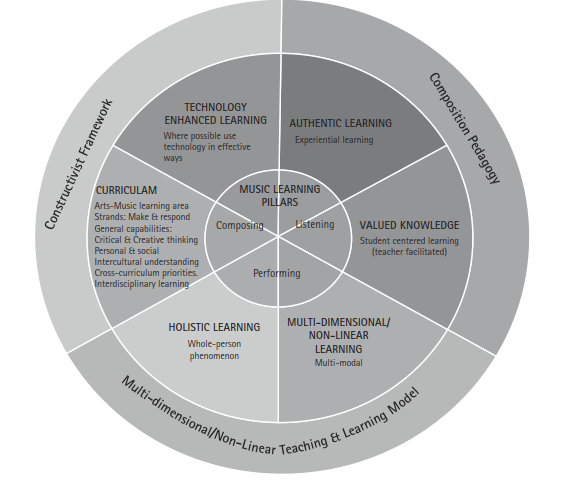Theoretical Underpinning: Approach to Music Education and Composition Pedagogy
The approach to music education and composition pedagogy in the cases discussed use Crawford’s (2008) multidimensional/non-linear teaching and learning model. Using a constructivist framework, this model relies on the tenets of authentic learning/experiential learning, student centered learning/valued knowledge and holistic learning/ whole-person phenomenon (Crawford, 2008, 2014). The theoretical underpinning for this model and its intersection with composition pedagogy is described in this section and later articulated in Figure 34.2.
The model prescribes students be provided with opportunities to connect new knowledge with prior understanding, aligning with Piaget’s (1954 and 1968) beliefs that the learner must be active to be engaged in real learning. Constructivists take this notion further: the learning environment should contain a meaningful context to construct knowledge, one that brings the real world into the classroom (Brown et al., 1989). Traditional learning situations in which students are passive recipients of knowledge are inconsistent with the learning situations that occur in real life (Lave, 1988).

Figure 34.2. Framework for using Crawford’s (2008 & 2014) multi-dimensional/non-linear teaching and learning model with composition pedagogy
If learning is to be authentic, students should be engaged in genuine learning problems or tasks that foster the opportunity for them to make connections between new material and prior knowledge. When engaged in authentic learning activities, students recognize the significance of what they are learning because the activities and tasks emulate real-life experiences related to the students and their world (Crawford, 2014). A current definition of authenticity states that knowledge, whether it is moral or informational, is based on consciousness, experience, and reflection (Marra, 2004).
With appropriate teacher facilitation and scaffolding, composition can be an authentic activity where students can learn to think critically, creatively and in multidimensional ways. They can communicate ideas multimodally, challenge their thinking, collaborate with peers, self-direct their learning, experiment with sound and musical elements, and create multiple possibilities/solutions that lead to informed decision-making. The learning process allows students to explore, discuss, and meaningfully construct concepts and relationships in defined contexts that involve real-world problems and issues.
Compositional activities involving increasingly complex forms of music, and different musical styles and genres, from a range of historical and cultural contexts and traditions, allow students to develop their own authentic musical voice and an appreciation of diverse musics. Socially inclusive practices and building intercultural competence are not only embedded in the learning opportunities students have to collaborate in creative endeavors, but the ways that thinking and meanings can be generated from different perspectives about music and its purpose that shift according to different authentic contexts or world encounters. Burnard (2012) conceptualizes distinctive forms of musical creativity that are rendered differently in response to experiencing music in different practice-based socio-cultural contexts. This contextually situated view of musical creativity allows learners to make and respond to music based on their sociocultural background and experiences (Kokotsaki, 2012).
Meaningful connections to personal experiences with music in their own lives and society are then considered a form of valued knowledge and consistent with the constructivist framework (Crawford, 2014). In the case studies presented, composition is situated at the center of learning and real-world experiences that align with (and stem from) students’ own interests and motivations are used as a springboard to deepen knowledge and broaden students’ musical experiences. Katz and Raths (1982) and Paul et al. (2001) explain that authentic learning activities should be context specific and involve authentic problems or issues that need to be solved within an environment that resembles and emulates actual professional practice, providing a “need to know" Research indicates that students tend to be highly motivated when working directly within an authentic context (Barrows, 1986; Kinsley & McPherson, 1995; Paul et al., 2001) and engaging in experiential learning (Elliott, 1995; Kolb, 1984) with content that is interesting to them and in turn considered valued knowledge (Crawford, 2014, 2017b). In this regard, engaging with the process of composition is purposeful, experiential, and reflective.
Holistic learning/whole-person phenomenon encompasses the collective ideas of valued knowledge, authentic/real-life learning, and multidimensionality/non-linearity (Crawford, 2008). It relies on the balance of intrinsic and extrinsic attributes and values inherent within learning music. Learning in such a context, although teacher facilitated, is student centered and self-directed, resembling the natural processes of real life, where students experience working as composers and artists. While the whole-person phenomenon has been used in other disciplines such as the medical field, in the educational context it is grounded by Dewey’s theory of experience (1958) as a way to think of learning as related to natural processes that contribute to the development of the whole person. In this context, the educational outcomes are holistic and consider the academic, personal, and social development of students. Learning is inspiring and highly motivational, often characterized as recursive and non-linear, engaging, self-directed, and meaningful from the learner’s perspective (Crawford, 2008; McCombs, 2000 and 2012).
A current definition of composition learning in music education refers to “the result of creative thinking in music that takes shape in a process of bringing a musical product into existence by an individual or group of composers” (Randles et al., 2012). While this is true in one sense, the multidimensional teaching and learning model delineates the type of process described, suggesting that engagement with compositional activity has the capacity to develop students’ critical and creative thinking. This slightly more complex view of composition learning aligns with the ideas about composition teaching and learning found in the seminal works Minds on music: Composition for creative and critical thinking and Composing our future: Preparing music educators to teach composition (Kaschub & Smith, 2009 and 2013). Paynter’s (1982 and 1992) principles for music learning identify composition as the superior musical activity and locates it at the heart of the music curriculum. This is consistent with the cases presented in this chapter and the ideas suggesting rethinking teaching and learning in music education through composition and creativity.
Date added: 2025-04-23; views: 152;
